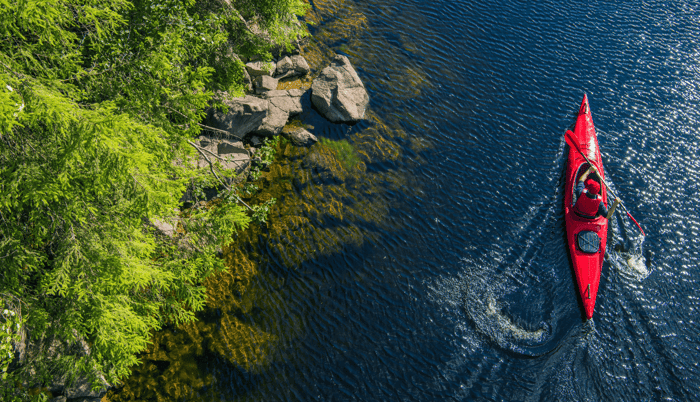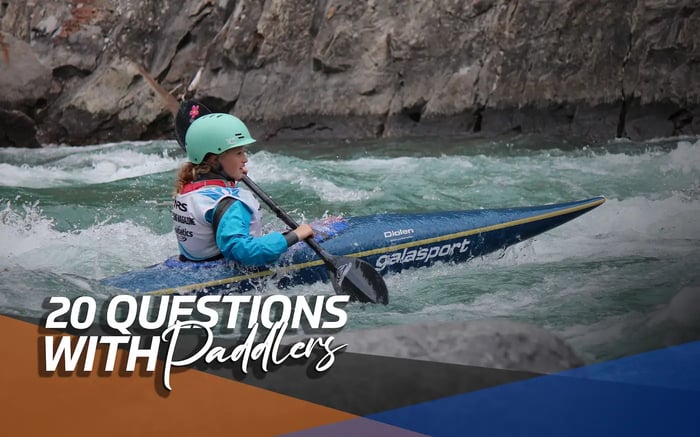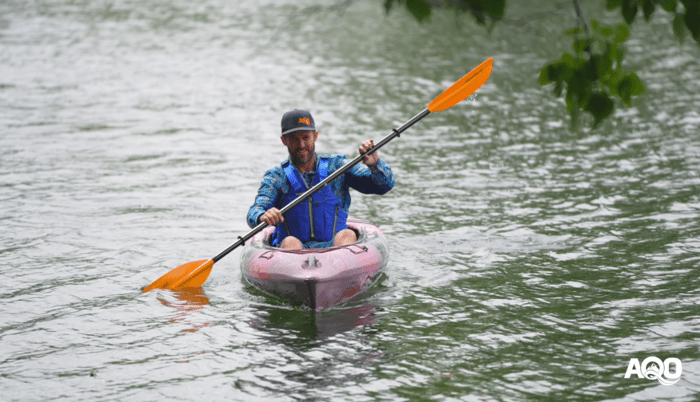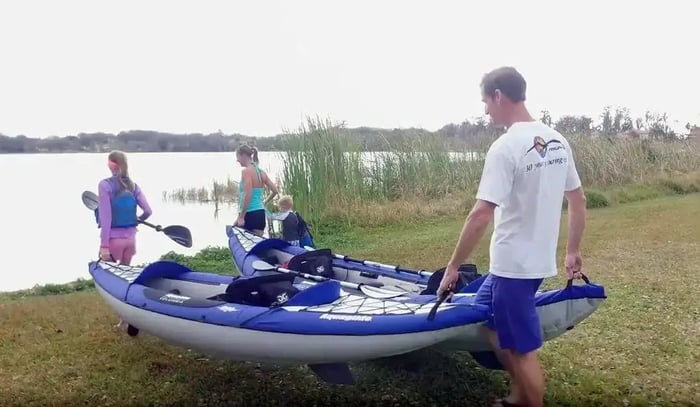We understand that finding the ideal kayak can be a daunting task, especially for beginners or those who have yet to fully explore the world of kayaking. With this guide, we aim to demystify the process and equip you with the knowledge necessary to select the perfect recreational kayak for your needs; be it lake adventures or meandering down calm rivers.
There are many factors to consider when choosing a recreational or touring kayak. This article is your comprehensive guide to the key differences between recreational and touring kayaks, how to choose the right one for you, along with a couple buying options in each category.
Recreational and Touring Kayak Buying Guide
What type of kayaking are you interested in?
The first consideration relates to the kind of kayaking you want to do. Are you focused on casual fair weather paddling trips on the water for a few of hours? If so, a recreational kayak is likely what you’re looking for.
If you're intending on getting into longer paddling excursions or multi-day trips where more gear storage is needed or you expect rougher water conditions, touring kayaks are the best option. Let’s talk about the differences.
Recreational Kayak 101
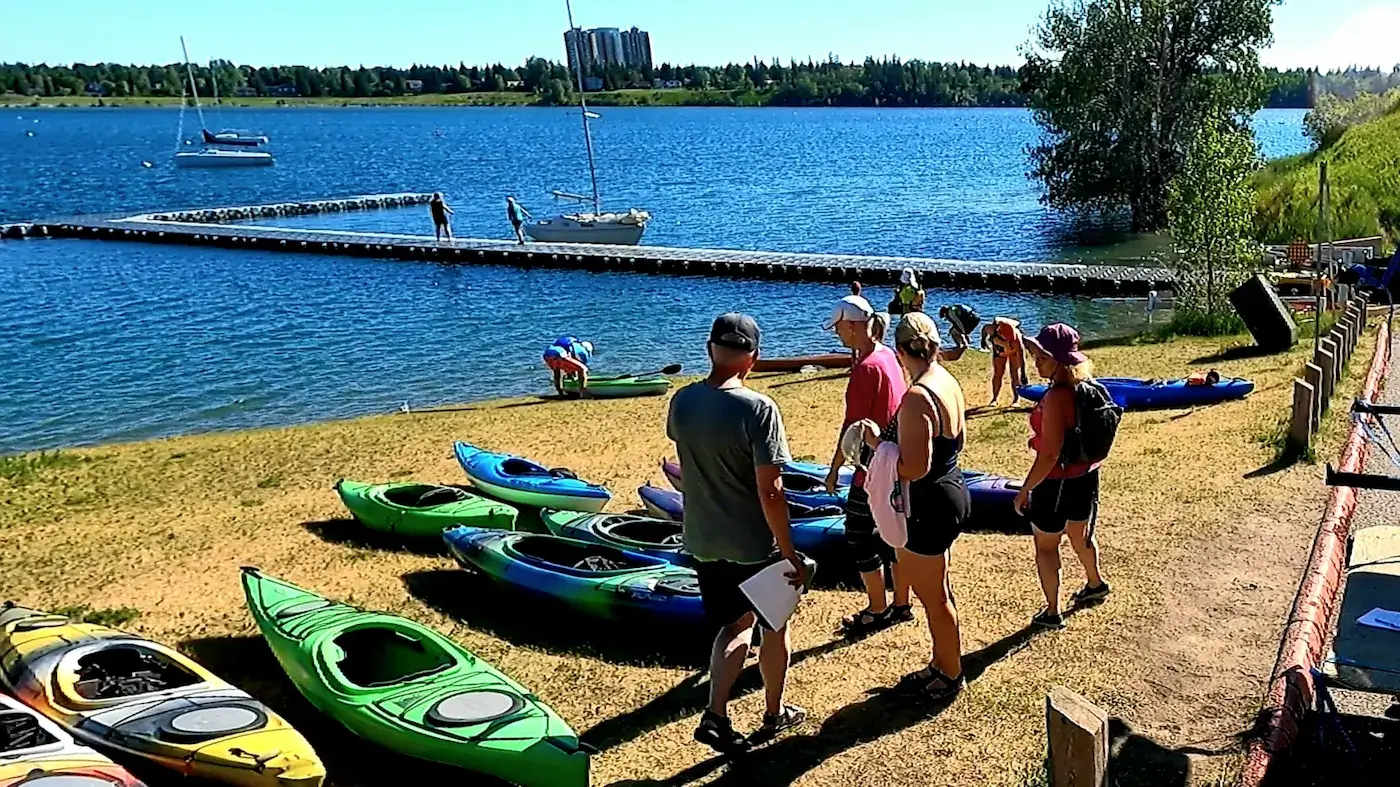
Recreational kayaks are a great option for paddlers interested in short distances on calm flat water and for float trips down low key easy rivers. New paddlers often choose recreational kayaks as they have lots of stability on the water, have a lower price point, and can be a great way to get into the sport.
Length and Width
Recreational kayaks are shorter boats on average, generally between 9’-12’ long. The shorter length makes them easier to turn and more maneuverable on the water but tracking (paddling in a straight line) is more difficult than in a touring kayak. Recreational kayaks are often lighter, making them easier to lift on and off a vehicle. Additionally, given that they are shorter, they may be a preferred option if storage space is a challenge.
These kayaks are typically between 26”-31” wide. This added width offers more primary stability, resulting in a less tippy feel on the water, but this also makes the boat slower.
Cockpit Size
Recreational cockpits are generally larger which makes the kayak easier to get in/out of. Some recreational kayak cockpits are designed so the paddler’s legs slide under the front deck of the kayak, whereas other larger cockpits are open and the paddler’s legs are exposed.
Some paddlers prefer a more open cockpit design as it feels less restrictive and the kayak is easier to get in and out of. Others may prefer a slightly smaller cockpit style with a snugger fit.
The best way to find out is to visit us in store and sample our various kayaks, where you can try getting in and out of them.
Bulkhead
Most recreational sit-in kayaks have a dividing wall (called a bulkhead) behind the cockpit area. Bulkheads create an air tight and water tight compartment that is accessed through a hatch on the deck of the kayak.
This sealed compartment offers additional buoyancy for safety in the event of a capsize, as well as a place to store your dry bag with additional items you may want to take out on the water such as extra clothes, lunch etc.
Seat Design and Outfitting
Recreational kayaks typically have a high back adjustable seat, which fits most paddlers quite comfortably. Depending on manufacturer, high back seat styles offer a number of adjustment options such as the height of the back rest, seat pan/leg lifter system adjustments and lumbar support. The outfitting of a recreational kayak also includes adjustable foot pegs and thigh padding for added paddler comfort.
Rocker and Hull Design
The rocker or curvature of the hull from the front (bow) to the back (stern) of a recreational kayak can vary. The more rocker on the hull, the easier it is to turn the kayak. But this also makes it harder to paddle straight.
Generally, recreational kayaks find a blend of rocker along with a V shaped hull design to increase tracking and stability. Some recreational kayaks have a molded keel at the stern of the kayak to support tracking and offer increased stability. Other kayak designs utilize a retractable drop down skeg built into the keel at the stern of the kayak, which offers reassuring stability and enhanced tracking on flat water.
Entry and Premium Recreational Kayak Options
Here are a couple of kayaks to consider for both an entry level recreational kayak as well as a more premium option.
Entry Recreational Kayak Option: Old Towne Sorrento
Old Town Sorrento 106SK Kayak

$1,119.99
$1,399.99
Recreational and Touring Kayak Buying Guide Which is Best for Lakes: Recreational or Touring Kayak? Canoe vs Kayak Beginners Guide to Recreational Kayak Gear The Old Town Sorrento 106SK Kayak is a day touring kayak that features a drop-down skeg… Read More
The Old Towne Sorrento is a good option to consider for a quality entry level kayak that comes in two lengths (10’6” and 12’6”). Sorrento kayaks are a durable single layer polyethylene kayak with two bulkheads and a good amount of rear hatch storage.
They are equipped with a drop down skeg, adjustable foot pegs and generous leg room for paddlers who may not want a closed cockpit design. The ACS2 seat (Active Comfort System) is super adjustable and one of the most comfortable recreational high back seats you’ll find.
Premium Recreational Kayak Option: Delta AR
Delta 10 AR Kayak

$1,295.00
Recreational and Touring Kayak Buying Guide Which is Best for Lakes: Recreational or Touring Kayak? Canoe vs Kayak Beginners Guide to Recreational Kayak Gear This lightweight Delta 10 AR Kayak brings a whole new level of performance to the world… Read More
A second option to consider is the Delta AR which comes in two lengths – 10’ and 12’. Deltas are a lightweight thermoform kayak making them easier to lift and carry. The Delta AR is a very stable kayak which utilizes a displacement hull design at the bow that cuts through the waves very well and transitions into a catamaran style at the stern of the kayak for enhanced streamline stability.
Delta 10 AR kayak features one stern bulkhead with a sealed hatch for dry storage in the stern. The bigger brother Delta 12 AR has two bulkheads with sealed hatches (bow and stern). Both have an under deck storage pod, and the same adjustable foot braces and Contour II Seat System that offers all day comfort.
Touring Kayak Basics
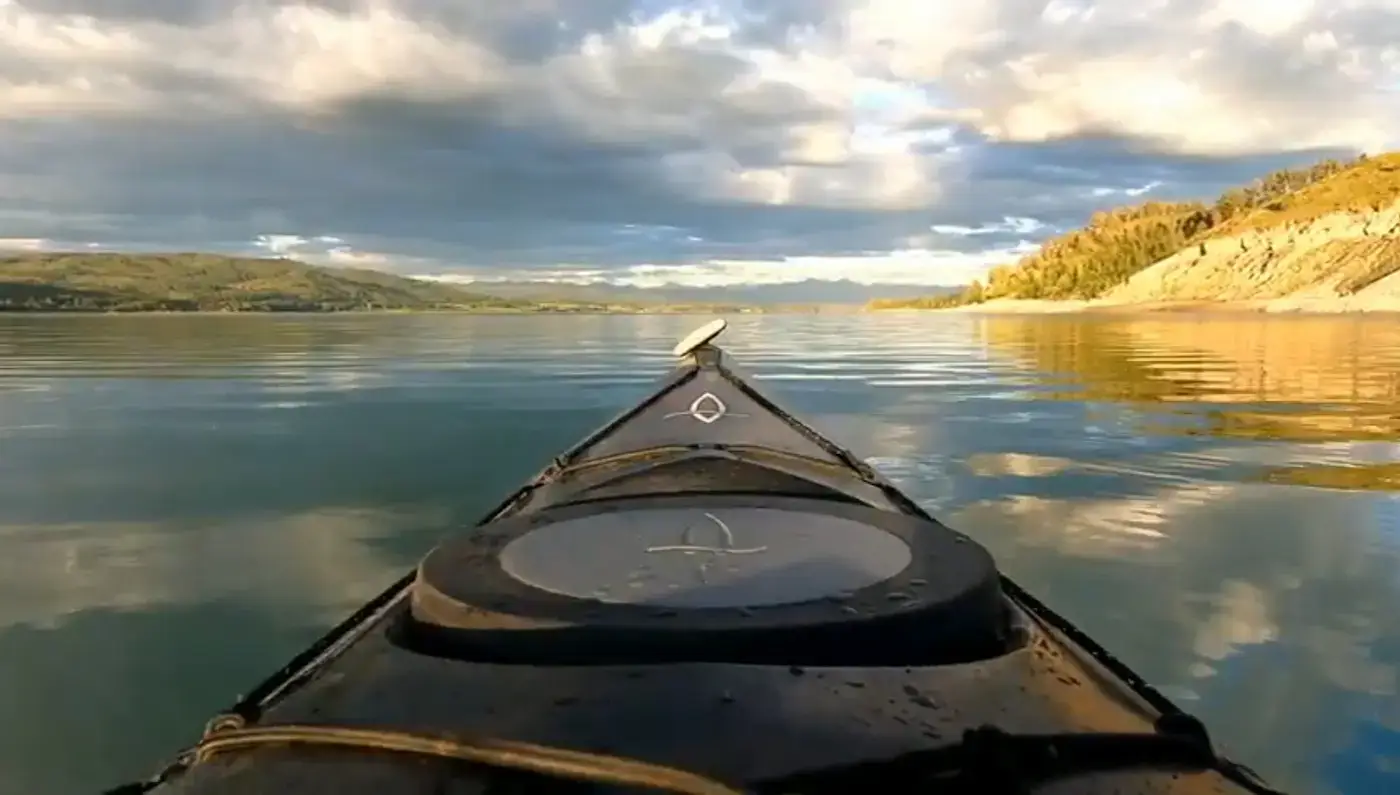
Touring kayaks are designed for paddlers interested in longer single or multi-day trips and where more storage is needed. They are a great option for paddling on both flatwater excursions or for longer, easier river trips.
These boats are also designed to handle rougher water conditions such as windy lakes with higher waves. Touring kayaks start at a slightly higher price point and are often paddled by kayakers with some previous paddling experience.
Length and Width
Touring kayaks are both longer and narrower than recreational kayaks, allowing the paddler to slice through the water. On average, they are between 12’-14’6” in length and offer much better tracking than a shorter recreational kayak. When paddling a long streamlined touring kayak, the sacrifice is that they are less maneuverable and take more skill and effort to turn.
Another consideration for paddlers who are leaning toward a touring kayak is the added length. This may create challenges both with transportation to the water and storage at home.
In terms of width, touring kayaks are narrower, ranging between 23”-25” across at the cockpit. Their long narrow streamline design definitely makes the touring kayak much faster on the water and allows the paddler to go longer distances with less fatigue.
Cockpit Size
Due to the narrow design of touring kayaks, some paddlers feel more confined in the cockpit at first. The cockpit may initially feel tighter, but the goal in a touring kayak is for the paddler to be well connected to the kayak, which means more control.
Bulkhead
Touring kayaks generally have two bulkheads, one in the stern and one in the bow. There are two accessible sealed compartments, again for enhanced safety offering additional flotation.
These compartments are accessed by opening the hatch covers to accommodate significant storage of camp gear, clothing, safety equipment and food etc. for longer paddling excursions.
Seat Design and Outfitting
The outfitting in touring kayaks incorporates a back band, as opposed to the tall seat back in the recreational style kayaks. This touring style of outfitting accommodates the use of a spray skirt to keep water out of the cockpit. This gives a paddler the opportunity to kayak in more adverse conditions, edge the boat when turning, or develop skills such as rolling the kayak.
Touring kayaks incorporate adjustable hip pads, thigh braces, and foot pegs -- all of which are the important connection points between the paddler and the kayak. Being solidly connected with the kayak at these points allows the paddler to effectively maneuver the kayak in any direction.
Rocker and Hull Design
Touring kayaks have a more aggressive V shaped hull which cuts through the water and increases paddling speed. There is less primary stability than what is offered in a wider recreational kayak so for newer paddlers, touring kayaks feel tippier at first.
There is more secondary stability when the kayak is up on its edge during a turn. Secondary stability also reduces the likelihood of capsizing when paddling in choppy water conditions.
Touring kayaks come with two options to assist with tracking and maintaining a straight directional course on the water. Some touring kayaks come with a drop down skeg, others come with a foot controlled rudder that flips down into the water. Both of these are effective devices to support better tracking in windy conditions.
Entry and Premium Touring Kayak Options
Entry Touring Kayak Option: Wilderness Systems Tsunami
Wilderness Systems Tsunami 125 Kayak

$1,849.00
Wilderness Systems Tsunami Review Recreational and Touring Kayak Buying Guide Which is Best for Lakes: Recreational or Touring Kayak? Canoe vs Kayak Beginners Guide to Recreational Kayak Gear The aesthetics of the Wilderness Systems Tsunami 125 Kayak inspire performance and… Read More
One solid option to consider if you are getting into touring kayaking is the Wilderness Systems Tsunami, which comes in three sizes: 125, 140 and 145. The 125 fits most medium size paddlers whereas the 145 will fit medium to larger/taller paddlers.
These kayaks are a comfortable day touring option with a high back seat, two bulkheads with sealed hatch storage, adjustable foot pegs and a molded keel at the stern of the kayak. The Tsunami has been around for a number of years and is worth checking out.
If you want to read more, check out the Wilderness Systems Tsunami Recreational Kayak Review.
Premium Touring Kayak Option: Dagger Stratos
Another option, and my personal favorite, is the Dagger Stratos. I’ve paddled this kayak for a couple of years and find it to be an exceptional kayak in its class. The Stratos is a sweet boat to paddle in a variety of conditions.
It comes in two lengths: 12.5 and 14.5. Each of these lengths comes in a small and large size. The Dagger Stratos is designed for performance touring and has foot braces, as opposed to foot pegs, for added connection to the kayak.
If you want to learn more, then check out my Dagger Stratos Touring Kayak Review.
Recreational and Touring Kayak Buying Guide Summary
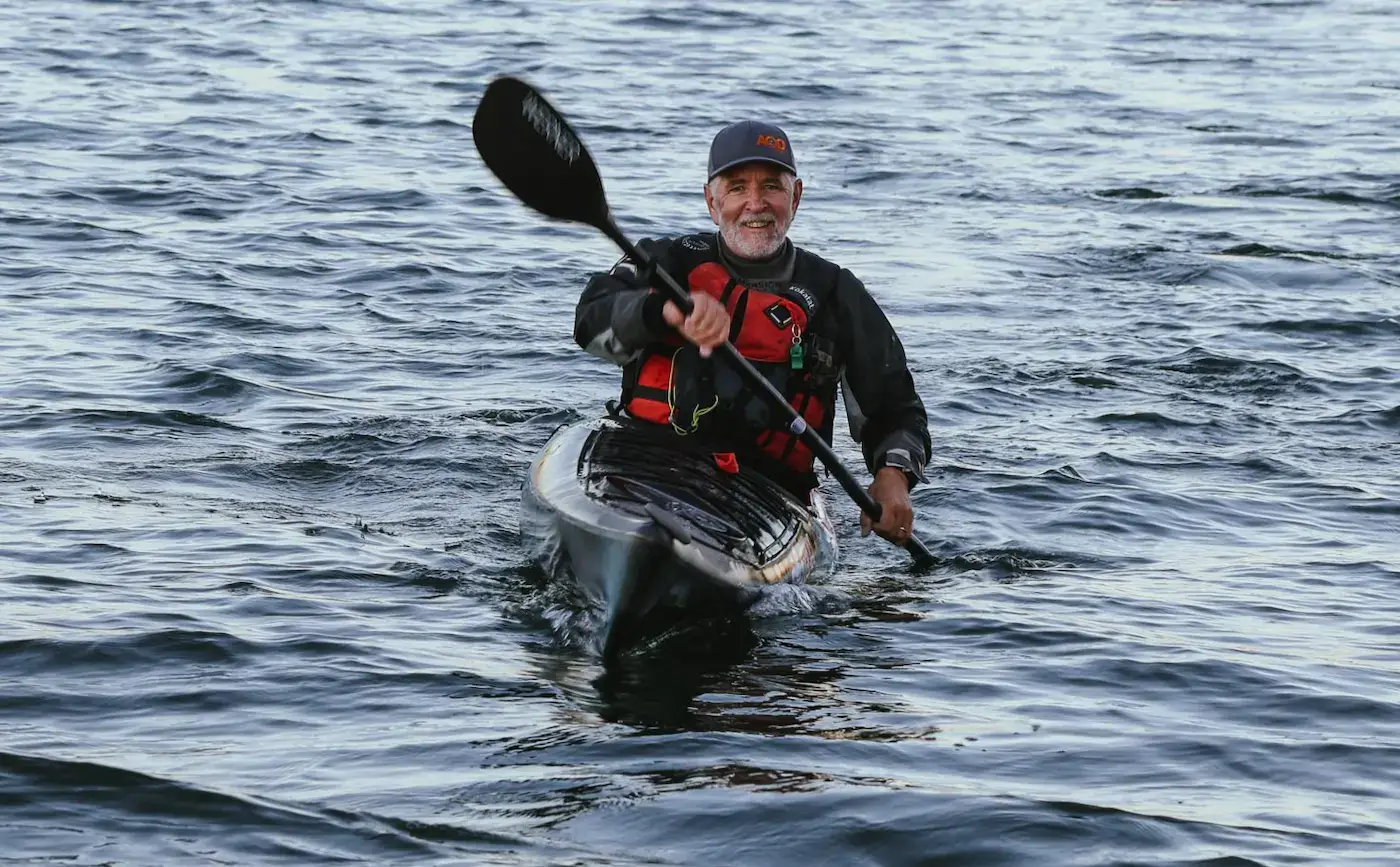
Whether your preference is recreational or touring kayaking, there’s plenty of great options to check out. I hope this has offered an understanding of the basics.
It’s best to get out on the water and paddle a few different kayaks to determine the best fit for you. Based on your paddling interests, you’ll want to ensure you’ve checked all the boxes in order to find the right kayak to meet your needs so you can truly enjoy your adventures out on the water.
If you have any further questions, feel free to contact us below or visit us in store!
Shop Recreational and Touring Kayak Collection
“create your own momentum”
Bryan Hume
https://www.facebook.com/bryan.hume.5/
https://www.instagram.com/brhume.yyc/
Check out my YouTube channel: The Life Of Bryak
https://www.youtube.com/channel/UCMoKbqlUHkiSXex2Tt43uZg
Related Recreational / Touring Kayak Articles
Choosing the Right Recreational / Touring Kayak for Lakes
Essential Recreational Kayaking Gear
Basic Paddles Strokes for Recreational / Touring Kayaking
Beginners Guide to Recreational Kayak Gear
High vs Low Angle Kayak Paddle Advice
AQ Outdoors Contact
Edmonton: (p) 780 463-4892 (e) info@aquabaticsedmonton.com
Calgary: (p) 403 288-9283 (e) info@aqoutdoors.com




















































